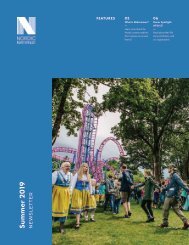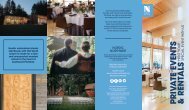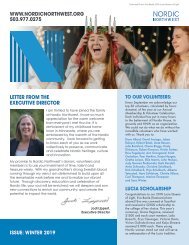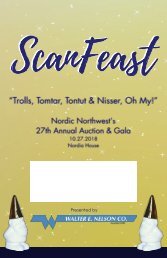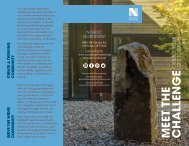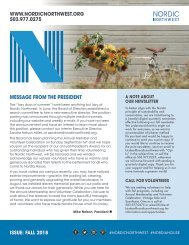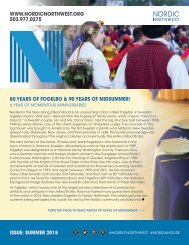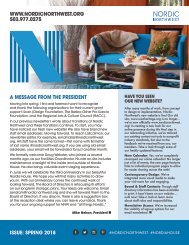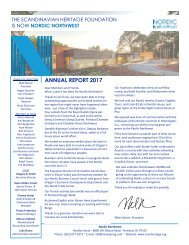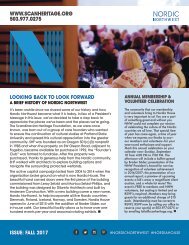Winter Newsletter 2017
Check out our Winter calendar, and seasonal information! See everything that's going on in the world of Nordic Northwest.
Check out our Winter calendar, and seasonal information! See everything that's going on in the world of Nordic Northwest.
You also want an ePaper? Increase the reach of your titles
YUMPU automatically turns print PDFs into web optimized ePapers that Google loves.
Page 2<br />
HYGGE<br />
THE INTERNATIONAL<br />
DANISH PHENOMENON<br />
In the last year, you have probably seen<br />
the word hygge. Well, the time of year to<br />
fully embrace the hygge lifestyle is upon us<br />
again: winter. A great portion of southern<br />
Scandinavia is on a similar latitude to Oregon<br />
and Washington, with a wet coastal chill and<br />
occasional snow. This is where hygge comes<br />
in, and why its popularity spread quickly in<br />
the Pacific Northwest.<br />
With over a dozen books on hygge published<br />
in the last two years, it’s clear that what the<br />
world needs is more warmth, more simplicity,<br />
more hygge. Adopting a hygge-centric<br />
lifestyle isn’t about going out and purchasing<br />
cozy socks, a shearling rug, and pounds of<br />
coffee. Hygge is a savoring of the existing<br />
elements of your life, and in good company.<br />
In Signe Johansen’s book, How To Hygge, she<br />
lays out a full picture of how to incorporate<br />
aspects of cozy Nordic vibes into your life. Try<br />
one or try them all, here are some of her best<br />
guidelines on how to do it:<br />
Spending time in nature calms you. It allows<br />
you to step back and to reflect on the very<br />
essence of what living is about.<br />
The Nordic spirit of self-sufficiency means<br />
knowing how to do and make a few useful<br />
things (as opposed to trying to master<br />
everything).<br />
Being kind isn’t just about the self, and those<br />
moments of quiet solitude. It’s also about<br />
spending time with others, about being<br />
sociable and taking pleasure in simple things<br />
together. It's community! All are welcome!<br />
Enjoy a visit to Nordia House this winter to<br />
get hygge-inspired. Take something home<br />
with you from our Vintage Sale or our Holiday<br />
Pop-up Shop! We also have outdoor walking<br />
paths, an in-house café Broder Söder, and<br />
special winter dinners to warm you up and<br />
have you saying “skål” to the upcoming<br />
season. •<br />
JULBORD<br />
Nordia House will be having a Julbord celebration in<br />
partnership with in-house Swedish café, Broder Söder, on<br />
December 15 from 6:00 - 9:00 PM! Call for tickets, and<br />
check out the other dinners in this Julbord series, including<br />
one at Broder Nord on December 2.<br />
Julbord——directly translated to Christmas table——is a longheld<br />
tradition in Sweden and Norway where the Christmas<br />
bounty is celebrated after the fast between Advent to<br />
Christmas Eve. A table is set for a decadent holiday buffet<br />
and always includes a few classic Scandinavian delicacies.<br />
Pork typically plays a starring role in the Julbord spread.<br />
During times of famine pigs were highly valued for their<br />
quick growth. Pork ribs, sausage, pâté, smoked julskinka<br />
(Christmas ham), and marzipan pigs can be seen during<br />
Julbord as a nod to their significance in Scandinavian history.<br />
Additionally, protein was difficult to come by in the dark<br />
season and meats like cured fished, including lox and pickled<br />
herring, were long-lasting. Put enough sauce and butter on<br />
the gelatinous white fish and it can be delicious!<br />
Take Home a Nordic<br />
Christmas Tradition!<br />
Rice porridge, known in Norway as risengrynsgrøt, is<br />
associated with the month of December. This warm pudding<br />
consists of rice soaked in boiling milk and is typically served<br />
with cinnamon, sugar, and butter. Risengrynsgrøt can be<br />
served before, during, or after a Julbord feast!<br />
Traditional Norwegian Rice Porridge Recipe<br />
Old-fashioned rice porridge is easy to make.<br />
Remember to stir regularly so it's not scorching!<br />
3 cups water<br />
1.5 cups glutinous rice, (pearl rice or medium grain)<br />
5 cups whole milk (or dried milk and water)<br />
1 ¼ teaspoons salt<br />
2 teaspoons vanilla sugar (optional)<br />
Let rice and water simmer on medium low heat in a heavy pot,<br />
uncovered, until most of the water is absorbed. Stir occasionally.<br />
This will take approximately 10 minutes.<br />
Add a cup of milk, continuing to add more over the next 45-50<br />
minutes while simmering on low heat. Stir well every five minutes<br />
or so.<br />
Add more milk whenever the porridge thickens as the milk<br />
absorbs until rice is nicely tender and porridge is thick and<br />
creamy.<br />
Add salt, and (optional) vanilla sugar; stir well and serve hot.<br />
If the porridge becomes too thick, add more milk to thin it.<br />
Throw blanched almond (or almonds depending on party size)<br />
into the pot and serve with sugar, cinnamon and a smørøye——a<br />
dice of butter placed in the middle of the bowl. •




